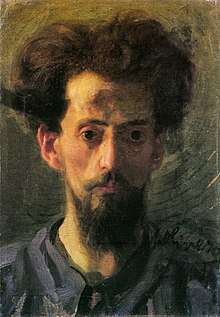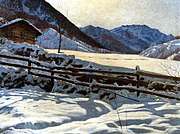Matteo Olivero
| Matteo Olivero | |
|---|---|
 Matteo Olivero, self-portrait, 1904. | |
| Born |
June 15, 1879 Acceglio, Italy |
| Died |
April 28, 1932 Saluzzo |
| Nationality | Italian |
| Education | Accademia Albertina delle Belle Arti, Turin |
| Style | Divisionist painter |
| Patron(s) | Luigi Burgo |
Matteo Pietro Olivero (15 June 1879 - 28 April 1932[1]) was an Italian painter, known for his technique of reproducing sunlight reflections without physically mixing colour pigments. For that matter he is considered a leading painter of the Italian divisionism, although he's still little-known outside art collector's environment.[2] In 1896 Matteo Olivero attended the Accademia Albertina delle Belle Arti in Turin. During his life he took part of several exhibitions across Europe and started a collaboration with "Les Tendances Nouvelles", a parisian art journal.
After a visit to a St. Moritz exhibition he became close friend of the painter Giuseppe Pellizza da Volpedo , with whom he started a written correspondence and, afterwards, a collaboration.[2]
Fatherless since early childhood, he was very close to his mother Lucia Rosano. He considered her an inspiration for his paintings. His mother died on 27 of March 1930 aged 86. The loss drove Olivero into deep depression. Luigi Burgo, a local businessman and owner of a paper mill, took Olivero under his custody, hosting him in his depandance house and becoming his patron.[3]
A relevant collection of his works is on display at the "Pinacoteca Matteo Olivero" in Saluzzo.
Death
On 28 April 1932, Olivero committed suicide by throwing himself out of a window.[3][4]
Gallery
References
- ↑ "Explore Matteo Olivero". rkd.nl (in Dutch). Retrieved 2017-11-13.
- 1 2 "Comune di Acceglio | Matteo Olivero | Convegno Matteo Olivero". www.comune.acceglio.cn.it. Retrieved 2017-11-13.
- 1 2 "Comune di Acceglio | Matteo Olivero | Opere e biografia". www.comune.acceglio.cn.it. Retrieved 2017-11-13.
- ↑ Dragone, Angelo (1959). Matteo Olivero pittore. Comitato Pro Saluzzo e le sue Valli.
External links
| Wikimedia Commons has media related to Matteo Olivero. |

